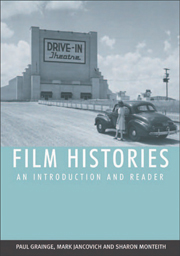Book contents
- Frontmatter
- Contents
- Preface
- Part I Film History from its Origins to 1945
- Part II Film History from 1946 to the Present
- 13 Postwar Challenges: National Regeneration, HUAC Investigations, Divestiture and Declining Audiences
- 14 The Politics of Polarisation: Affluence, Anxiety and the Cold War
- 15 Cinematic Spectacles and the Rise of the Independents
- 16 New Waves, Specialist Audiences and Adult Films
- 17 Radicalism, Revolution and Counter-Cinema
- 18 Modernism, Nostalgia and the Hollywood Renaissance
- 19 From Movie Brats to Movie Blockbusters
- 20 The Exhibitors Strike Back: Multiplexes, Video and the Rise of Home Cinema
- 21 Postmodernism, High Concept and Eighties Excess
- 22 Cults, Independents and ‘Guerrilla’ Filmmaking
- 23 From Cinemas to Theme Parks: Conglomeration, Synergy and Multimedia
- 24 Globalisation and the New Millennium
- Bibliography
- Copyright Acknowledgements
- Index
19 - From Movie Brats to Movie Blockbusters
from Part II - Film History from 1946 to the Present
Published online by Cambridge University Press: 05 August 2013
- Frontmatter
- Contents
- Preface
- Part I Film History from its Origins to 1945
- Part II Film History from 1946 to the Present
- 13 Postwar Challenges: National Regeneration, HUAC Investigations, Divestiture and Declining Audiences
- 14 The Politics of Polarisation: Affluence, Anxiety and the Cold War
- 15 Cinematic Spectacles and the Rise of the Independents
- 16 New Waves, Specialist Audiences and Adult Films
- 17 Radicalism, Revolution and Counter-Cinema
- 18 Modernism, Nostalgia and the Hollywood Renaissance
- 19 From Movie Brats to Movie Blockbusters
- 20 The Exhibitors Strike Back: Multiplexes, Video and the Rise of Home Cinema
- 21 Postmodernism, High Concept and Eighties Excess
- 22 Cults, Independents and ‘Guerrilla’ Filmmaking
- 23 From Cinemas to Theme Parks: Conglomeration, Synergy and Multimedia
- 24 Globalisation and the New Millennium
- Bibliography
- Copyright Acknowledgements
- Index
Summary
If the late 1960s and early 1970s witnessed a fascination with the art cinema within the Hollywood mainstream, the late 1970s is often seen as a ruthless reassertion of the supposed conservatism of commercialism and entertainment. However, it was the new generation of largely college-educated ‘movie brats’ who had been central to the modernist Hollywood of the previous period who were central to the shift from the modernist art cinema to blockbuster fantasies. Furthermore, while this moment is often associated with a nostalgic reference to the Hollywood past, as has already been pointed out, the modernist moment was itself ironically infused with a reverence for the golden age of classical cinema.
Despite this shift, the period from 1975 to 1980 is also distinguished by another feature. The importance of the director as a figure had grown dramatically in the late 1970s and during this period successful directors acquired considerable power. This was also exacerbated by a situation in which the studios were increasingly reliant on a few hit films a year to cover costs. By the end of the decade, though, many directors had developed a reputation for reckless extravagance and self-indulgence.
- Type
- Chapter
- Information
- Film HistoriesAn Introduction and Reader, pp. 435 - 456Publisher: Edinburgh University PressPrint publication year: 2007



